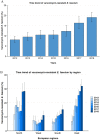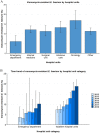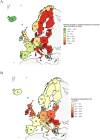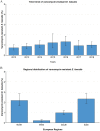The ongoing challenge of vancomycin-resistant Enterococcus faecium and Enterococcus faecalis in Europe: an epidemiological analysis of bloodstream infections
- PMID: 32498615
- PMCID: PMC7448851
- DOI: 10.1080/22221751.2020.1769500
The ongoing challenge of vancomycin-resistant Enterococcus faecium and Enterococcus faecalis in Europe: an epidemiological analysis of bloodstream infections
Abstract
Vancomycin-resistant enterococci infections are of great public health significance due to limited therapeutic options. We investigated epidemiological trends and risk factors of vancomycin resistance in enterococci isolates from patients with bloodstream infections in the EU/EEA from 2012 to 2018. Routine vancomycin susceptibility data of clinical E. faecium (n = 67,022) and E. faecalis (n = 103,112) blood isolates from the European Antimicrobial Resistance Surveillance Network were analysed using descriptive statistics and multivariable regression analyses. In Europe, proportions of vancomycin-resistant E. faecium (VREFm) increased from 8.1% (95%CI 6.7-9.7%) in 2012 to 19.0% (95%CI 16.8-21.5%) in 2018. Rising VREFm proportions were observed across all European regions, both genders and all age groups except children and adolescents (1-19 years). Adults (20-59 years) and elderly (≥60 years) had an increased likelihood of VREFm compared to children and adolescents (1-19 years) (OR: 1.99 [95%CI 1.42-2.79, p < 0.001] and OR: 1.56 [95%CI 1.09-2.23, p = 0.014], respectively). Inpatients hospital units, including internal medicine and ICUs, were associated with an increased likelihood of VREFm (OR: 2.29 (95%CI 1.58-3.32, p < 0.001) compared to the emergency department which reflects patients with community origin of E. faecium infections. The mean proportion of vancomycin-resistant E. faecalis in Europe was found to be low (1.1% [95%CI 0.9-1.4%]). Local and regional authorities should intensify efforts directed at diagnostic and antimicrobial stewardship for vancomycin and all last resort drugs for the management of VREFm, particularly for hospitalized elderly patients.
Keywords: VRE; VREF; Vancomycin-resistant Enterococcus faecium; vancomycin-resistant Enterococcus faecalis; vancomycin-resistant enterococci.
Conflict of interest statement
No potential conflict of interest was reported by the author(s).
Figures





References
-
- Fisher K, Phillips C.. The ecology, epidemiology and virulence of Enterococcus. Microbiology. 2009;155(Pt 6):1749–1757. - PubMed
-
- Lee T, Pang S, Abraham S, et al. . Antimicrobial-resistant CC17 Enterococcus faecium: The past, the present and the future. J Glob Antimicrob Resist. 2019;16:36–47. - PubMed
-
- Wittea RW W, Klarea I.. Enterococcus. Chemotherapy. 1999;45:135–145. - PubMed
Publication types
MeSH terms
LinkOut - more resources
Full Text Sources
Medical
